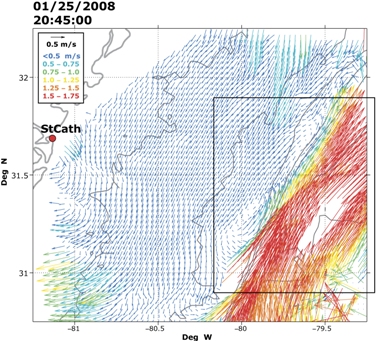Skidaway Institute of Oceanography professor Dana Savidge aims much of her research efforts towards observing the way ocean currents move in the Gulf Stream and across Georgia’s continental shelf. Those efforts have paid off in the discovery of a series of previously unidentified eddies which may have a significant influence on the way energy and material are transported between the Gulf Stream and the shelf waters.
Savidge’s findings were published in a recent issue of Geophysical Research Letters. Jonathan Norman from Armstrong Atlantic State University also contributed substantially to the analysis, along with several members of the Skidaway Institute team, including Trent Moore, Julie Amft and Catherine Edwards.
These researchers observed Shelf Edge Tide Correlated (SETC) eddies by using low-power, high-frequency radar systems that monitors surface ocean currents across the continental shelf and out into the Gulf Stream. The small, short-lived eddies spin up along the western edge of the Gulf Stream twice daily, as the tide turns. They move southwesterward, along the shelf edge — sometimes drifting towards shore — before dissipating two or three hours later.

In this graphic depiction of radar-derived coastal currents, the color, length and direction of the arrows represent the velocity of surface currents. The Gulf Stream is clearly evident in red and yellow. A Shelf Edge Tide Correlated eddy can be seen in the box on the left edge of the Gulf Stream.
According to Savidge, the importance of the SETC eddies lies in their influence on the Gulf Stream. “The Gulf Stream transports an incredible amount of heat and kinetic energy,” she said. “It has a strong influence on the global climate.”
In addition, fluctuations or meanders in the Gulf Stream’s flow pull nutrient-rich cold water from the deeper ocean and onto the shelf, providing a basic food source for marine life. The newly-discovered eddies apparently affect both those processes.
“These are processes we didn’t know were happening that affect how the Gulf Stream transports heat and energy,” Savidge said. “This is information that must be put into a model if you want the model to accurately reflect what the Gulf Stream is doing in terms of transporting heat and energy.”
The nutrients from the deep ocean that the SETC eddies lift across the shelf edge and into the sunlit upper regions of the coastal ocean may contribute to phytoplankton growth, thereby potentially contributing resources for the shelf’s wider range of marine life.
“Similar eddies may occur along other continents where currents like the Gulf Stream exist, so it will be important to determine how important they actually are in the complex interaction between the Gulf Stream and the coastal waters.” Savidge said.
The research was funded with grants from the National Science Foundation and the National Oceanic and Atmospheric Administration (NOAA). The radars were purchased with funding from the Georgia Research Alliance and NOAA.



